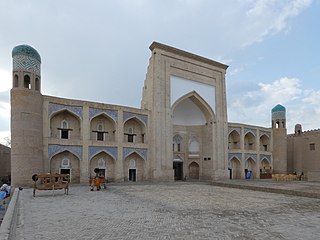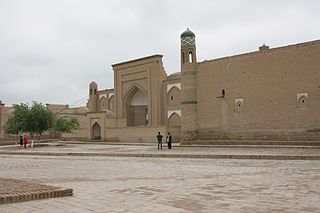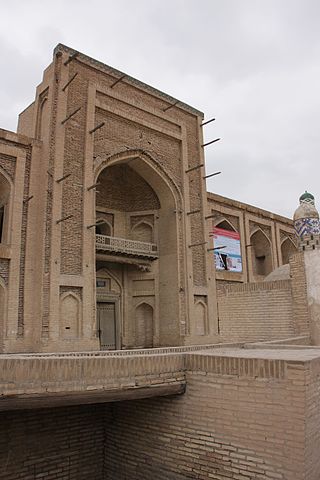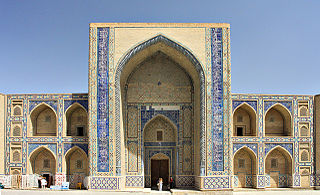
Bukhara Region is a region of Uzbekistan located in the southwest of the country. The Kyzyl Kum desert takes up a large portion of its territory. It borders Turkmenistan, Navoiy Region, Qashqadaryo Region, a small part of the Xorazm Region, and the Karakalpakstan Republic. It covers an area of 40,216 km2. The population is estimated at 1,976,823 (2022), with 63% living in rural areas.

Chor-Bakr is a memorial complex in the village of Sumitan at 5 km of Bukhara in Uzbekistan, built over the burial place of Abu-Bakr-Said, who died in the year 360 of the Muslim Calendar, and who was one of the four of Abu-Bakrs (Chor-Bakr) – descendants of Muhammad. The complex includes the necropolis of family tombs, and courtyards enclosed with walls.

The architecture of Uzbekistan is noted for its originality. Many consider Uzbekistan's architecture to be notable despite the changing economic conditions, technological advances, demographic fluctuations, and cultural shifts that the country has experienced.
Usta Shirin Murodov was a Soviet Uzbek master artist – a painter, pottery craftsman, and folklorist. He was an honorary member of the Academy of Sciences of Uzbekistan SSR (1943) and a distinguished artist recognized for his contributions to the art in the Uzbek SSR (1943). He was also the recipient of the First Degree Stalin Prize (1948).

Kutlugmurad Inak madrasah - an architectural monument in Khiva (1804–1812); it is a part of Itchan Kala. Madrasah was built by Allah Kuli Khan's uncle Kutlugmurad Inak; he was buried under the floor of the miyonsaroy (corridor) according to his will.

Arab Muhammadhan Madrasah is an architectural monument, part of Itchan Kala, in Khiva, Khorazm Region, Uzbekistan. Today, the monument is located at 27 Zargarlar Street, Itchan-Kala neighborhood.

Nodir Devonbegi is a historical memorial in Bukhara, Uzbekistan. It was established by Nodir Devonbegi, the vizier and brother of the ruler of Bukhara, Imamquli Khan, in 1620–1621. The Khanaka has been included in the national list of intangible cultural heritage objects of Uzbekistan.

Ulugbek Madrasah is a memorial to Abdul Khaliq Ghijduwani, located in the city of Gijduvon in the Bukhara region of Uzbekistan. It is one of the ancient and renowned madrasas of Bukhara, also known as the "Fayziya Madrasah." Presently, it is also referred to as the Mirzo Ulugbek Madrasa. This prestigious educational institution was built in the Hijri year 836 beside the grave of Shaykh Abdul Khaliq Ghijduwani, with a two-story structure made of baked bricks. The Ulugbek Madrasah, established by Ulugh Beg, is the third and last madrasa he founded, relatively smaller and simpler compared to the Ulugbek Madrasah in Bukhara and Samarkand.
Shergazikhan Madrasah is an architectural monument in Khiva (1719-1726). It is one of the many buildings in the Itchan Kala. According to the sources, it was built in 1719–1726 with the funds and decree of the Uzbek ruler Shergazikhan (Shir Ghazi Khan). It is located in the center of Itchan Kala, at the entrance to the Pahlavon Mahmud complex. The construction of the structure began during Shergozikhan's campaign to Khurasan. Khan's body was buried in a small room built in the west of the madrasah.

Amir Tora madrasah is a cultural heritage object located in the historical center of Khiva region in Uzbekistan. It was taken under state protection as an architectural monument. It is located in the northern part of the Itchan Kala.
Khoja Kurban Madrasah is a two-story madrasa located on the Abdulhaliq Gijduvani street, Abdulhaliq Gijduvani neighborhood, Bukhara city, Bukhara Region, Republic of Uzbekistan. It is included in the national list of real estate objects of material and cultural heritage of Uzbekistan.

Abdullakhan madrasah is an architectural monument located in the north of the Koshmadrasa ensemble in Bukhara, Uzbekistan. This madrasah, which is a perfect example of the architecture of the Uzbek ruler Abdullah II, demonstrates all the creative achievements of Bukhara architecture in the 16th century.

A'lam madrasah is a two-story madrasah located in the historical center of the city of Bukhara, Bukhara Region, Republic of Uzbekistan. It is included in the national list of real estate objects of material and cultural heritage of Uzbekistan.

Chuqur madrasah is a one-story madrasa building located in the historical center of the city of Bukhara, Bukhara Region, Republic of Uzbekistan. It is included in the national list of real estate objects of material and cultural heritage of Uzbekistan.

Daniyol Atalik Madrasah is an architectural monument. The one-story madrasah was built in the 1770s under the patronage of the Uzbek ruler Muhammad Daniyolbi. In the sources, it is also called Qorikhana. Bahauddin Naqshband was the second madrasah built after Mazari Sharif Higher Madrasah.

Ibrahim Akhund madrasah is a two-story madrasah located in the historical center of Bukhara city, Bukhara region, Republic of Uzbekistan. It is included in the national list of real estate objects of material and cultural heritage of Uzbekistan. The Varakhsha Archaeological Museum is in the building.

Istehza madrasah is a two-story madrasah building located in the historical center of the city of Bukhara, Bukhara Region, Republic of Uzbekistan. The smallest madrasah in Central Asia. It is included in the national list of real estate objects of material and cultural heritage of Uzbekistan.

The Turkman Madrasa is a two-story madrasa building located in the historical center of Bukhara city, Bukhara region, Republic of Uzbekistan. It is included in the national register of immovable property objects of Uzbekistan's material and cultural heritage.

Tursunjan madrasah is one of the Bukhara madrasas. A two-story madrasah building located in the historical center of the city of Bukhara, Bukhara Region, Republic of Uzbekistan. It is included in the national list of real estate objects of material and cultural heritage of Uzbekistan.

Ulugbek madrasah is an architectural monument (1417) in Bukhara, Uzbekistan. It is the oldest preserved madrasah in Central Asia. It is the oldest of the madrasah built by Ulugbek. During the reign of Abdullah Khan II, major renovation works were carried out (1586).

















